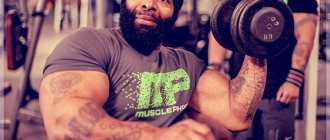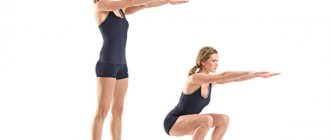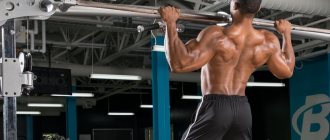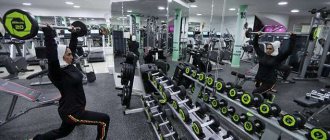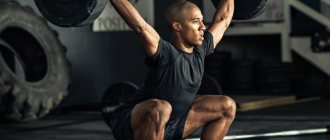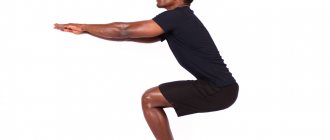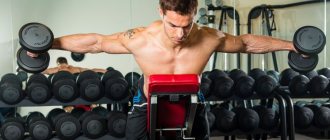Recommendations to follow
Here are just a few effective exercises, which are the basis in the complex of exercises for the buttocks of many famous trainers - they are just slightly modified so that weakened muscles get used to the exercises little by little, and so that it is not boring to do them.
So, here is a set of simple exercises that will help strengthen your muscles and tighten your buttocks and thighs. These exercises are ideal for doing at home.
The best time to practice is in the morning. Get up a little earlier than usual and sit on the mat. If you are not afraid to disturb anyone, turn on the music. And get started!
Main etiological factors
Causes of hip pain:
Injuries to the femur or hip joint after a fall or blow. Professional athletes and people involved in physical activity are susceptible to injury. Fracture of the upper or middle part of the femoral neck. Elderly people are susceptible, they occur in women, due to menopausal disorders. Hormonal changes in mature and elderly women lead to the development of osteoporosis
Fractures appear after careless movement or a fall from one’s own height. Treatment is long and does not always bring the desired effect
In some cases, the formation of a false joint occurs. Fracture of the sacral part of the pelvic bone, pubic bone. Characterized by sharp pain in the groin. An x-ray is taken to differentially diagnose a dislocation in the hip joint. Compression injury in the first lumbar vertebra after falling from a great height and landing on the buttocks. Bruises of the pelvic area.
Sprains and bruises of the soft tissues of the femoral region, internal, biceps, quadriceps muscles. In older people, soft tissue injury results from wear of the ligaments and degenerative changes in the surface of the articular head. In young people, injuries occur after physical activity. Inflammatory diseases in the left hip joint, fibromyalgia, ankylosing spondylitis. The temperature of the joint increases, it turns red and swells. Diseases of the vessels of the thigh and iliac region. If pain occurs in the groin, thrombosis of the femoral or iliac artery may develop. Endocrinopathies, infectious diseases, including osteomyelitis.
Hip pain is caused by physical activity that destroys cartilage and soft tissue. Inflammation in the soft tissues, after injury, irritates the sciatic nerve. This causes pain in the gluteal muscle and back of the thigh. The pain reaches the heel area. The patient cannot stand or sit for a long time.
Nagging pain can be caused by the characteristics of the hip joint, changes in the soft tissues. Pain in the thigh above the middle third or in the groin is caused by pathology in the spine - osteochondrosis, disc arthrosis, narrowing of the spinal canal. Curvature of the spine causes spasm, pain in the muscle of the front surface of the thigh.
If leg pain is left untreated, the frequency and nature of the pain worsens.
Hip and thigh injuries are often treated with surgery. In case of a displaced fracture, the bone fragments are fixed with special knitting needles and titanium plates. In the postoperative period, gymnastics are performed. Perform exercises for the upper body and healthy limb.
Femur fracture
For fractures in older people, surgical treatment in some cases is not performed due to contraindications. The patient is cared for and prevented from bedsores.
Exercise 1 - hip lift and abduction
Lie on your right side, lean on the elbow of one hand, place the palm of the other in front of you, bend your knees 90 degrees.
Raise your left leg as high as possible - exhale, lower it to the starting position - inhale.
Repeat the exercise 25 times . Turn over to the other side and perform the exercise with your right leg.
Then complicate the task a little: lean on the palm in front, move the knee of your working leg as far back as possible. Repeat the exercise 25 times for each leg.
Purpose: This is an effective exercise for losing weight on the outer thighs; it trains the outer thigh, which many consider a problem area.
What to pay attention to : To correct the position faster and get maximum effect, watch your pelvis and shoulders - they should remain in one line. It’s better to relax the knee and toe while swinging the leg, then exactly those muscles that need to be tightened will be involved in the work.
How can a man lose weight in his thighs?
The problem of full hips is extremely rarely relevant for men - body structure and hormonal status suggest completely different problem areas for the stronger sex. Most often, there is a problem of general fatness, which is advisable to solve by correcting nutrition and physical activity.
In principle, any advice given in the article is also relevant for men. However, if there is abnormal fullness in the hip area, it is worth contacting an endocrinologist to rule out hormonal diseases that could cause such an anomaly.
Exercise 2 - lying straight leg swing
Lie on your back, place your hands, palms down, under your buttocks and point your toes out.
Swing your straight leg - exhale, lower it to the floor - inhale. Repeat 25 times with each leg.
What to pay attention to : To work the muscles in the front of your thighs, pull your toes as hard as possible and do not relax until you complete the exercise.
Do not bend the working leg at the knee; it is better to make the swing a little shorter. And when the muscles get used to the load, feel free to increase the amplitude.
Do not strain your neck or arch your chest. To avoid helping yourself with your hands, turn your palms up.
Purpose: This is an exercise for losing weight on the front of the thigh.
The most effective loads
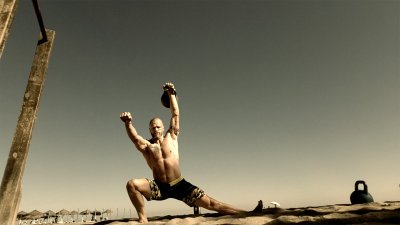
According to most experts, when losing weight, including in the hip area, you should pay attention to the following types of loads:
- Cardio. First of all, running and jumping rope, as they not only help you burn extra calories, but also load the right muscles.
- Circuit training. We are talking about sequentially performing exercises on different muscle groups with minimal rest between repetitions.
- High-repetition strength exercises - standard loads on the hips, legs and buttocks, but use lighter weights that will allow you to perform 20 or more repetitions. To lose weight in the hips, the basis will be various squats, leg bending/extension in the simulator, lunges, straight-legged deadlifts, and so on.
- Interval training, that is, alternating loads of varying degrees of difficulty.
- Supersets, that is, sequential execution of exercises for one muscle group, for example, an athlete squats, lunges and extensions, and only then takes a short break, after which the circle is repeated.
- Classic strength exercises. We are talking about multi-joint movements such as squats, straight-legged deadlifts, and so on.
Taking into account the individuality of any body, the goal of an athlete or his coach is to choose the most effective set of exercises that will work and improve results. In this case, reduce the volume of the hips.
To tighten the gluteal muscles
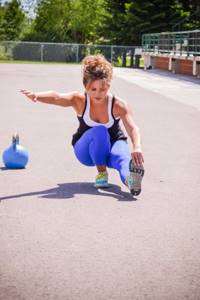
The goal of the training process is the subsequent achievement of a result that corresponds to the set goal. Simple weight loss will not always be justified, since the appearance of the body may not suit the athlete even after losing a kilogram, even with a decrease in the volume of the hips.
Toned muscles with a minimal layer of fat is the main goal of most people involved in sports. To do this, you need to choose the right set of exercises.
Tightness is achieved due to the fact that the muscles are toned. Therefore, it is important to load the right part of the muscle, and not just lose excess fat.
The most effective exercises for loading the buttocks are:
- Sumo squats. The difference from regular squats is the wide stance of the legs. Read how to properly do squats for weight loss by following the link.
- Raising the pelvis from the floor. Such exercises for losing weight on legs and thighs at home can be performed in the absence of any equipment.
- Lunges. Can be performed with both a barbell and dumbbells. Another option is to perform the exercise “in a step”.
- Various Pilates exercises, such as back lunges, compression bridges, squats with knees together, and so on. Many movements can be performed without additional weight or equipment.
If the buttocks are toned and tightened, but the muscles are developed and relatively voluminous, other deficiencies can be artificially “camouflaged.” For example, small imperfections in the waist and legs may be hidden. This is another reason to keep this muscle group in good shape and pay special attention to its training.
To burn fat on the outside and inside of the legs
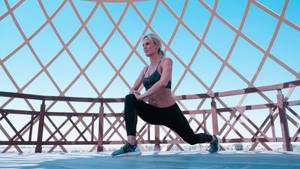
First of all, the athlete must understand that local fat burning is impossible. No amount of exercise will reduce fat in one part of the body without affecting another.
It is possible to lose weight in general, so you should be skeptical about programs that focus on reducing the volume of the legs, waist and offer to completely remove fat from the inside of the legs and so on.
You can keep certain muscles toned. It’s even possible to “pump up” a certain muscle, make it stronger, but not reduce the fat around it.
But if the goal is beautiful legs, then you should carefully study the exercises aimed at training them. These include:
- Classic squats. Allows you to load your legs as a whole, as well as your buttocks and partly your back (when using a barbell). Multi-joint and heavy exercise.
- Leg press in the simulator. They can almost completely replace squats if you have back problems.
- Leg extensions in the simulator. A high-rep version with light weight is recommended to avoid damaging your knees.
- Various home exercises - stepping onto a bench, squats with a side step, horizontal swings, and so on.
- Leg abduction in the simulator. Perfectly pumps the inside of the legs.
Those losing weight are recommended to use a circular approach with light weights, for example, perform all the exercises without rest, one after the other, several circles, depending on the level of training.
Exercise 3 - lifting the lower straight leg to the upper one
Lying on your right side and leaning on your elbow, place your right leg on the floor so that it is at a right angle to your body.
Raise your left one up and clasp her ankle with your hand. Raise your straight right leg to your left - exhale, return to the starting position - inhale.
Repeat 25 times on each side.
What to pay attention to . In order for the muscles of the inner thigh to work, the feet need to be pulled towards you.
And the toe of the leg that is currently working should, if possible, “look” down. Pull heel to heel.
Purpose: exercise for the inner thigh.
Nervous structure

Their function is to transmit signals from the central nervous system and back to enable the muscles to move the limb correctly. They also allow the skin to sense touch and temperature changes. If there are disturbances in this area, a person begins to have problems with the muscles of the thigh, flexion and extension of the knees. The main nerve passing through the pelvis along the posterior and outer regions of the femur has a similar name. Its branches provide communication with the central nervous system of almost all organs and tissues of the upper leg. Peripheral nerves branch from the main trunk:
- subcutaneous;
- internal musculocutaneous;
- lateral and anterior cutaneous;
- median muscular.
The obturator nerve, which runs from the lumbar plexus along the lateral wall of the pelvis, also plays an important role. It diverges into two branches - articular and muscular, which connect the corresponding structures near the obturator canal with the central nervous system.
The corresponding part of the genital femoral nerve innervates the oblique and transverse muscles in the inner thigh and the skin near Scarpa's triangle.
The first of them, with the help of lateral branches, innervates the muscular tissues of the dorsal surface of the thigh, participating in flexion of the knee joint. Additionally, it transmits signals to the fibers of the midfemoral region, assisting its adductor actions. The sciatic nerve ends with two large branches - the common peroneal and tibial.
The second, with the help of auxiliary branches, creates the conditions for motor innervation of muscle tissue behind the lower leg. Through its actions, it promotes extension of the ankle joint and flexion of the toes. Responsible for their motor function are two nerve endings located in the sole of the foot.
The common peroneal branch innervates the corresponding muscles, as well as the ventral tissues of the leg, which allows free flexion and lateral movement of the ankle. The influence of this branch is also responsible for the extension of the fingers.
The posterior cutaneous branch participates in the motor innervation of the pelvis, creating conditions for the work of the gluteus maximus muscle. In addition, its activity helps abduct the femoral joint and provides sensitivity to the dorsal femoral surface and the top of the ankle joint.
Exercise 4 - hip raise from a prone position
Lie on your stomach, stretch your arms along your torso, spread your straight legs as wide as possible and bend your knees. Stretch your toes up, trying to lift your knees and hips off the floor as much as possible.
On each rise, exhale, returning to the starting position - inhale. Repeat 25 times.
What to pay close attention to: When working the lower body and especially the muscles of the buttocks, not a single muscle should be tense in the neck and back.
This way you will protect your lower back from unnecessary stress.
Anatomy of the thigh muscles
Conventionally, the muscle mass of the thigh is divided into three parts:
- The front part is the quadriceps.
- Back – biceps femoris.
- Internal – adductor muscles.
Particular attention should be paid to the quadriceps - the quadriceps muscle of the thigh. It consists of four bundles: intermediate, direct, medial and lateral. They form most of the volume of the thigh muscles.
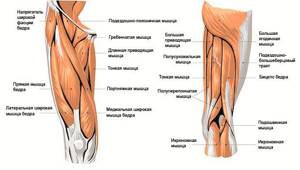
Exercise 5 - lying on your stomach, counter movement of your hips
Remain on your stomach with your hands tucked under your thighs, palms up. Bring your legs together, bend your knees and cross your ankles.
Raise your lower body as high as possible - exhale, gently lower it down - inhale. Repeat 25 times.
Be sure to relax your back: . After abdominal exercises, you need to pay attention to your lower back.
Place your palms and knees on the floor and round your back as much as possible, just like cats do.
One or two repetitions are enough to relieve tension.

